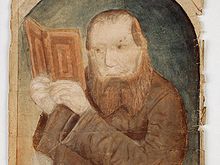Brynjólfur Sveinsson
Brynjólfur Sveinsson (born September 14, 1605 in Holt ( Önundarfjörður ), † August 5, 1675 ) was one of the 16 Lutheran bishops of Skálholt .
The Icelandic 1000 kroner banknote features a portrait of him.
Life
After attending the Skálhólt School, Brynjólfur went to Copenhagen, where he studied Classical Philology and Philosophy: a choice of studies that shaped his critical view of the witch hunt of his time. There he made contacts with the most outstanding thinkers of the north such as Ole Worm . He then worked for six years as vice principal at the school in Roskilde .
In 1638 he was about to go on a study trip to the Netherlands when he was surprisingly elected to the bishopric of Skálhólt. Christian IV did not accept his letter of renunciation . In May 1639 he was consecrated bishop in the Frauenkirche in Copenhagen.
Of the children from the marriage with Margrét Halldórsdóttir only one daughter, Ragnheiður, and one son, Halldór, who died in England in 1666, survived.
Brynjólfur Sveinsson died on August 5, 1675 without a biological heir.
Medieval manuscripts
The bishop's name is closely associated with medieval manuscripts , largely because of three well-known texts that passed through his hands .
In 1643 a collective manuscript with Old Norse mythological and heroic poetry came into the possession of the clergyman. He gave her the name "Sæmundar Edda ". Brynjólfur attributed this manuscript to Sæmundr Sigfússon (inn fróði) by combining and reinterpreting the hypotheses of an "older" Edda as the forerunner of the Snorra Edda , and Sæmundr as the author of the latter. However, modern research agrees that the creator of the work (whether in the sense of “author” or “compiler”) could not have been Sæmundr. Rather, the manuscript, also known as the Codex Regius, is based on a large number of sources; the manuscript contains texts of very different ages and is otherwise quite inconsistent in terms of content and style. The dates of life of the author assumed by Brynjólfur and the probable date of origin of the manuscript (around 1270) also do not match, so that an authorship is excluded.
A manuscript of the Old Norse Snorra Edda , the so-called Codex Upsaliensis , also came into the hands of the Icelandic clergyman before he passed it on to the Danish historian Stephanius in 1639 .
Finally he also found a manuscript of the Book of Icelandic Islands (Íslendingabók), which was copied by one of his priests, but was lost shortly afterwards.
Hymns and psalms
Brynjólfur Sveinsson, who was bishop from 1639 to 1675, was, what is less known, also a poet and wrote hymns and psalms. He promoted Hallgrímur Pétursson , Iceland's most famous psalmist to this day, and helped him to find parish posts.
Aftermath
Brynjólfur Sveinsson is one of the main characters in the opera Ragnheiður by the Icelandic composer Gunnar Þórðarson , which was performed with great success in 2013/2014 and which deals with the fate of Brynjólfur's daughter Ragnheiður.
literature
Non-fiction
- Gunnar Kristjánsson (Ed.): Saga Biskupsstólanna. Skálholt 950 ára - 2006 - Hólar 900 ára. Hólar, Reykjavík 2006, ISBN 9979-77684-6 .
Fiction
- Guðmundur Kamban : Skálhólt - fyrri hluti. Jómfrú Ragnheiður. Selfoss, Sæmundur, 2015 (original publication date: 1930)
See also
| predecessor | Office | successor |
|---|---|---|
| Gísli Oddsson |
Bishop of Skálholt 1639 - 1674 |
Þórður Þorláksson |
| personal data | |
|---|---|
| SURNAME | Brynjólfur Sveinsson |
| BRIEF DESCRIPTION | Icelandic Lutheran Bishop |
| DATE OF BIRTH | September 14, 1605 |
| PLACE OF BIRTH | Holt ( Önundarfjörður ) |
| DATE OF DEATH | August 5, 1675 |


